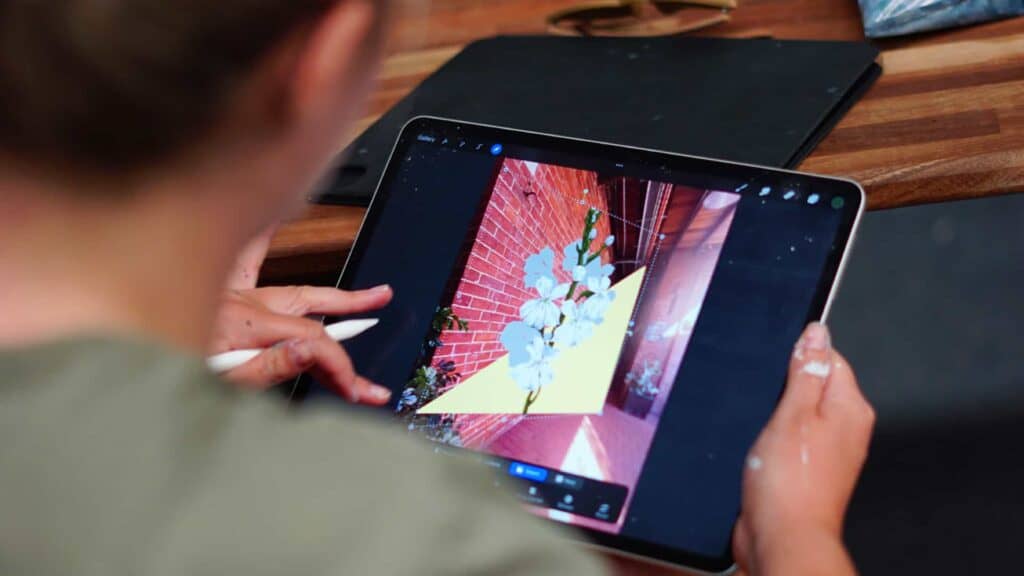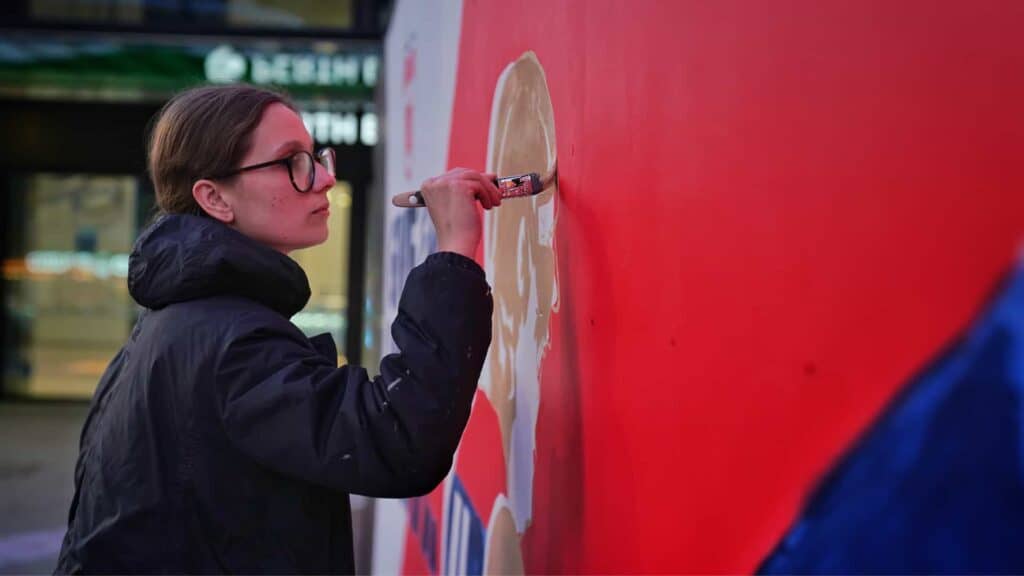The Ultimate Guide to Hiring a Mural Artist
- 20 minute read

Table of Contents
Introduction
Murals are more than just eye-catching artwork; they can transform a space, tell a story, and leave an everlasting impression.
Whether you aim to elevate your commercial space or invigorate a blank wall at home, commissioning a mural is usually a straightforward process. Some projects, however, may involve complexities that require careful consideration and planning.
If you’re looking for a comprehensive and easy-to-follow guide on commissioning your dream artwork, you’re in the right place. This guide will walk you through the entire process, from defining your project and hiring a mural artist to the aftercare of the mural.
We use the term “mural” to refer to large-scale, commissioned artwork painted directly on walls, ceilings, or structural surfaces. While street art and graffiti are sometimes linked to illegal or unauthorised acts, we include legitimate and authorised street art and graffiti within our definition of a “mural”.
In this article, we also frequently refer to a single artist for your project, but you can choose to hire any number of artists for your project.
As a living guide, we continually review and update this content.
Now, let’s get started.
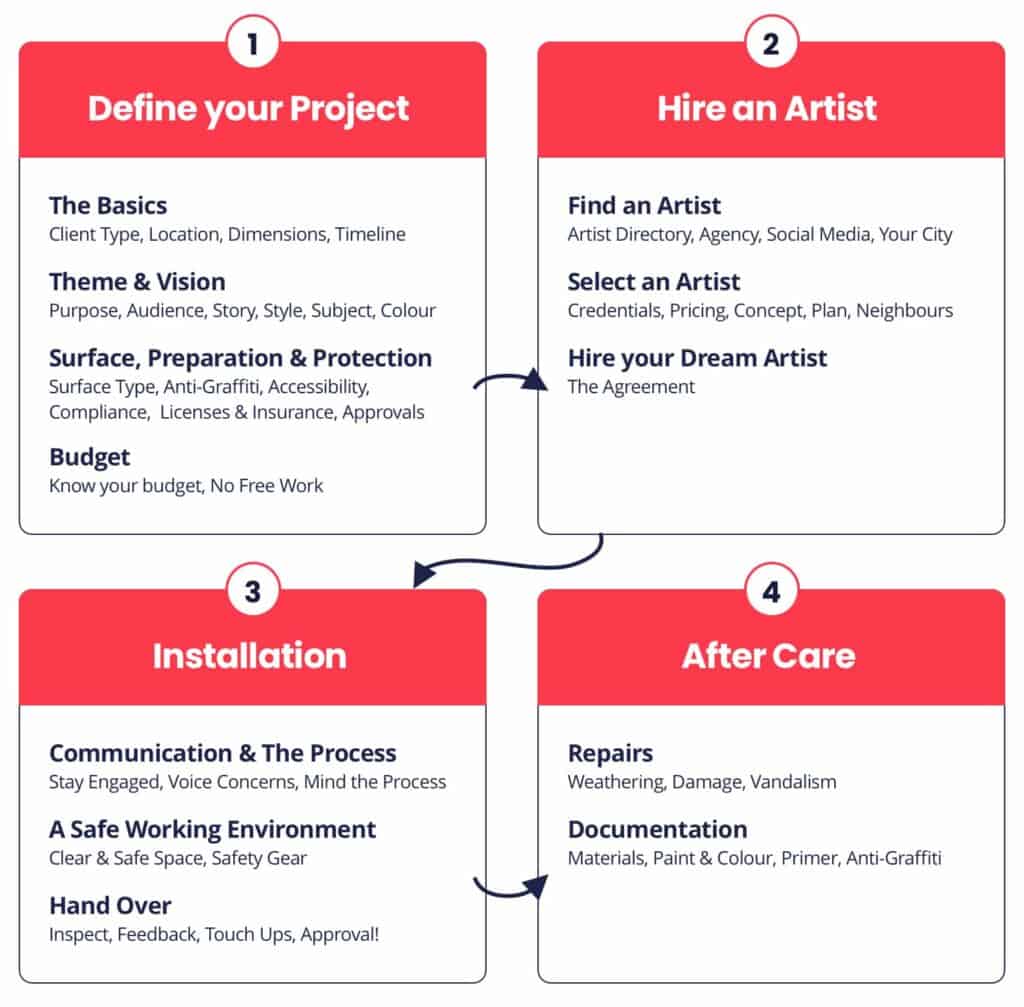
Define Your Project
The Basics
Let’s explore our project’s basic elements.
Client Type
Is your project commercial or residential? Commercial projects may call for artists with appropriate experience and credentials, requiring a week or several weeks to complete from the first stroke or spray.
Residential projects are usually smaller and can be completed within one to two weeks.
Location
Where is your project located? Rural or remote areas may only work for some artists and will have a greater influence on your choice of artists and budget.
Will your mural be indoors or outdoors? This will determine the kind of materials used and the time of the day an artist can work, considering shade and the weather.
Consider your artist’s access to the wall, parking, temporary storage for materials and equipment, power point availability, and the stability of scaffolding or scissor lifts on the ground if relevant.
Dimensions
What are the total dimensions of the surface? Note down its width and height.
Timeline
When does your project need to be delivered? Establish a project start date and deadline that works for you, your construction project or commercial fit-out.
Depending on the size of your project, conceptualising and sign-off may take one to several weeks.
Artists are their own bosses; some are happy to work at odd hours, whether it be very early, late or even on the weekends. Note what times work best for you and can also provide safe access to the artist.
Project Type
You can present any of three mural briefs for your project as a client.
- Curated Mural Brief: Often, an artist works closely with you to realise your vision. This collaborative process results in an artwork that combines your input and the artist’s unique style, creating a harmonious and tailored piece. Some may call this a closed mural brief, but the word is restrictive to its true form.
- Open Mural Brief: You can give your dream artist complete control of a project, perhaps capped to a budget. Your artist has the freedom to conceive the idea and design for the artwork and may draw inspiration from an area of their choice. This is a canvas to showcase their unique artistic style and approach.
- Collaborative Mural Brief: An artist collaborates with the community to create ideas for the artwork through discussions and workshops. The artist develops a concept and, together with the community, participates in the artwork’s installation, fostering a sense of shared ownership and engagement.
These project types cater to a diverse range of clients, including private individuals, commercial entities, government organisations, or those open to public tenders.
Theme and Vision
Let’s define an essential part of your project – your theme and vision!
The theme and concept of a mural play a crucial role in setting the tone and message it conveys. Themes can be broad, such as nature, history, or community. They can also be more specific to your brand or personal story.

When discussing the theme and concept with a mural artist, consider the following:
- Purpose: Identify the primary purpose of the mural. Are you looking to inspire, educate, or entertain?
- Audience: Consider what will resonate with your mural’s audience. Is it for your guests, customers, employees customers, or community?
- Storytelling: A mural has the power to tell a story or convey a message. The artwork can ignite personal passions and histories or highlight characteristics unique to your community.
- Style: The artistic approach, such as (but not limited to) realism, impressionism, street art, or a mix of styles. Letter or Font styles also make for powerful design choices.
- Subjects: Brainstorm ideas for visual elements you’d love to see in the art. These can include nature, native wildlife, hand lettering, abstract shapes, geometric patterns, or portraiture. You can even incorporate your brand, logo, local landmarks, or cultural symbols.
- Colour: The overall colour scheme or specific colours you want to incorporate, such as warm or cool tones, black and white, certain hues or colour palettes of themes like the sunset, ocean, jungle, or your brand.
By considering these elements and discussing them with your artist, you will enjoy smooth collaboration and a final product that meets your expectations.
It’s important to note that Indigenous artists should create Indigenous artwork out of respect for their culture. If your desired design aims to incorporate Indigenous history, people, or themes, it’s essential to consult with local Indigenous elders for guidance, demonstrating cultural sensitivity and respect.
Surface, Preparation & Protection
The surface of your wall is a critical detail that will affect the artist’s choice of material and surface preparation. Typical surfaces include:
- Brick
- Render
- Textured Surface
- Corrugated Metal
- Powdered Painted Surfaces
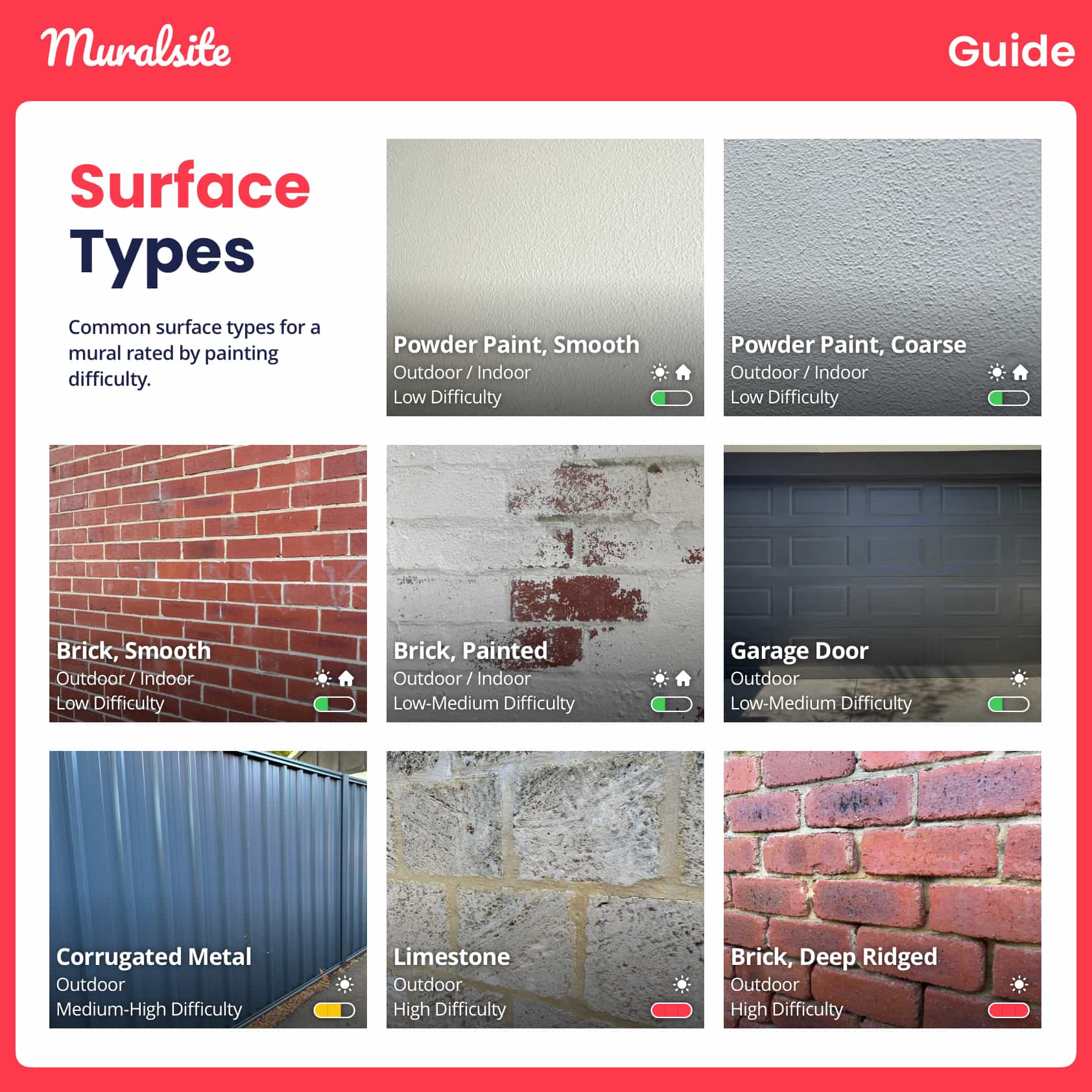
Preparation
Depending on the condition of the surface, preparation may involve a light sugar soap scrub, high-pressure wash, or base coat application.
Inspect the surface for signs of water damage or peeling paint, as further damage could cause bubbling and ruin your commissioned artwork.
Consult your artist on what preparation is needed for your project. Before they start painting, some artists may request you hire a contract painter to apply a primer or base coat to the surface.
A contract painter may also be needed to inspect and address any water damage before an artist can begin their installation.
If your surfaces have an existing anti-graffiti coat, directly applying paint can cause bubbling, and a suitable method for removing the coating is needed. In this case, consult a contract painter for the best course of action.
Anti-Graffiti Coat
Street-facing walls may be the target of vandalism. As much as we dislike it, we’ve seen beautiful murals tarnished more times than we’d like.
Fortunately, we can opt to protect our investment with an anti-graffiti coat. An artist or contract painter can apply this protective clear coat to help preserve the mural from dirt, vandalism, and weathering.
Depending on the coat, a hose and scrub will wash away unwanted amendments.
Accessibility
Your project’s unique dimensions and characteristics may require equipment like a ladder, scaffolding, scissor lift, or cherry picker. Consider whether the environment is safe to accommodate any of the available options.
Accessibility may affect the overall cost and timeline in complex or large projects.
Compliance
To protect both you and your project from potential complications, it’s essential to address matters of compliance. Let’s look at the licenses and insurances your artist may need and obtain approvals from relevant parties if needed.
Licenses & Insurance
Certain clients and situations require all on-site contractors to hold appropriate licenses and insurance. These include construction sites and projects for large organisations like shopping malls and local councils.
Licenses include:
- A White Card
- Working from Heights
- Elevated Working Platform
Insurances include:
- Public Liability Insurance
- Products Liability
- Property in Care Custody/Control
- Professional Indemnity
Approvals
You may need to give notice or get approval from your local council, municipality, property owner, or operator before commissioning a mural project.
Understanding and adhering to their guidelines and process is important to avoid any unwanted trouble and ensure a successful project. For example, the following elements may be prohibited:
- Unpleasant imagery or negative, offensive messages
- Sexualised content
- Illegal activities, violence or threats
- Glorification of smoking or alcohol and drug consumption
- Business logos, advertising signage or commercial promotions

If you intend to include directional signage, a logo, or products in a mural, refer to the advertising and signage policy of the council or property operator.
If you are unsure whether your project or concept needs approval, do not start the project!
Your Budget
Finally, have a clear budget in mind before approaching artists. Your budget strongly influences the outcome and determines how much detail, style and effort an artist can dedicate to the project.
Please do not offer projects in exchange for “exposure”. Free work should not be encouraged, especially if you benefit and get value from the outcome.
We’ll learn about mural pricing methods later in this article, but for the purpose of budgeting, please consider the need for equipment hire if accessibility may otherwise be challenging (see the accessibility section). Surfaces like coarsely textured render and corrugated metal require extra time and effort to get right.
Now that we have clearly defined our project by considering these key factors, you have a solid understanding of your mural’s requirements and are prepared to find the perfect artist.
Hire an Artist
Where can I find an Artist?
Now that we have considered your project requirements, theme, vision and budget, let’s find an artist.
Consider these questions when searching for an artist:
- Does the artist have a portfolio that matches your theme, style and desired emotion? Their work doesn’t need to closely match, as some artists are happy to adapt to their client’s vision.
- Do they have relevant experience executing projects of your type, scale, complexity and professional requirements?

Artist Directories
We have a clear bias here, but online artist directories like Muralsite are the easiest way to find artists near you. Unlike other directories, we don’t charge artists or you a commission. Instead, we plan to offer a low-cost subscription-based service to artists to publish their profiles and portfolio and get access to our member benefits and resources.
Simply browse the artists and projects in your area and contact them directly on their own channels. We do not get in the middle of the relationship between you and your artist. We take special care to uphold our standards for professionalism and quality artistry in our members.
Post a Job
You can also post a job on a directory/marketplace like Muralsite. Simply complete this form and wait for artists to contact you directly if your project is something they’re interested in.
Agencies & Consultants
There are many outstanding agencies and creative consultants that have helped produce remarkable art projects.
Agencies specialise in connecting clients with their resident artists. Both agencies and consultants bring their valued creative skills and approaches to the table and have experience managing various art projects.
Commercial clients and brands that want to entrust a quality outcome to an expert usually hire agencies and consultants. Their fees typically include a margin for the services they provide.
Social Media
Social media platforms like Instagram and Facebook can be great resources for discovering mural artists. Many artists showcase their work here, making it easy to browse different styles and find artists whose work resonates with your vision. You can search for local artists using relevant hashtags, location tags, or following local art groups and organisations.
Your City
Your city and local community can be a valuable resource in your search for a mural artist. Take a closer look at the mural to find the artist’s name or handle. You can search for them on social media or Google.
Selecting an Artist
Now that we’ve identified our dream list of artists let’s contact them.
Tell them what you’re looking for with a project brief based on the key considerations discussed in the first section.
Usually, artists and clients organise an initial consultation to discuss the project in more detail, the budget, and its timeframe requirements. This consultation may be in person, by email, via video call or over the phone.
Next, organise an on-site inspection. The artist will ask you questions about the project vision and requirements and take measurements if possible.
Verify Credentials
Construction projects, local councils, and some organisations require all contractors to hold relevant tickets, licenses, training and insurance. Ask your artist for details on these credentials before moving forward if needed.
Pricing
One of the most popular questions an artist receives is how do you price your work? There isn’t a clear single best way or one-size-fits-all approach. An artist’s pricing method depends on their preference and experience.
Artists have used the following pricing methods:
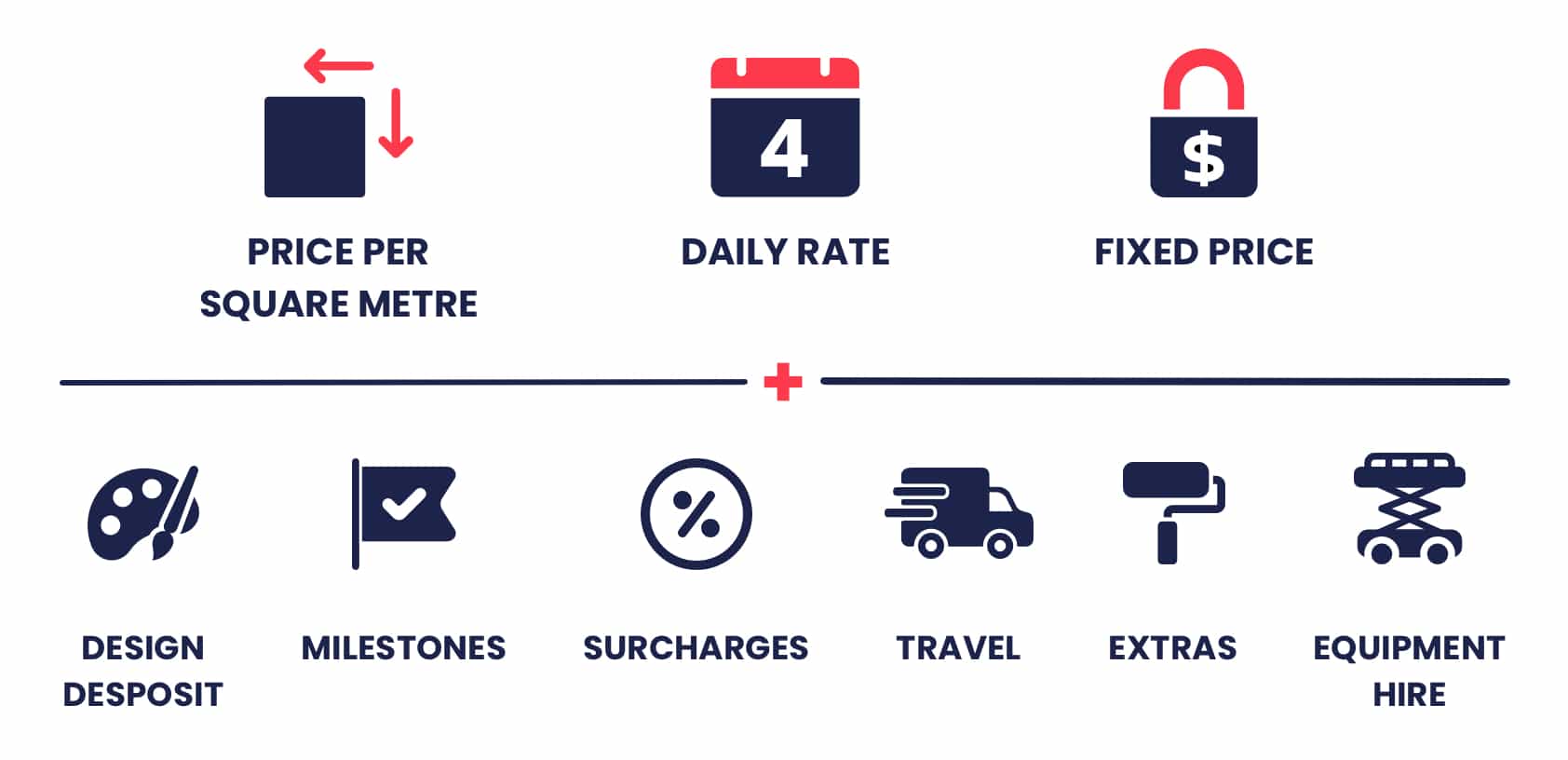
- Price per square metre: A straightforward approach that accounts for the project’s scale. An artist will typically provide different prices for increasing levels of detail in the artwork: low, medium, and high detail. Mixed levels of detail are common.
- Daily rates: An artist may have a fixed daily rate and commit or estimate the number of days to complete the project. The number of days required is again determined by the level of detail called up by the concept and other factors.
- A fixed price: Some artists may choose to provide a fixed price for a project based on the above methods and other considerations. You may find this in high-value projects where it’s hard to come up with an accurate estimate of effort. A contract defines what happens in the event of a project variation to protect the artist from cost overruns.
Ask your artist whether paint, materials and labour are included in their pricing.
Here are a few more pricing tools artists use:
- Design Deposit: A deposit charged by an artist before they start creating a project’s concept art. The deposit ensures an artist is fairly compensated for their time and effort if a project doesn’t proceed. A deposit may run between $150-$1,000 or a percentage of the estimated total value of the project. The artist has the discretion to deduct the deposit from the total project value.
- Milestone payments: Large projects that run over $15,000 and two weeks of work may include milestone payments determined by the artist. For example, a milestone may be set as follows: 50% payable at project kickoff, 25% at the project’s halfway mark, and the remaining 25% minus a deposit payable upon final project delivery and sign-off. Every artist may do this differently.
- Surcharges: Our working title for supplementary fees an artist may apply to their chosen pricing structure when a project includes elements that demand extra time or expense. Most commonly, artists charge more for corrugated metal surfaces, as their intricate forms present difficulties in accurately rendering the concept artwork.
- Travel Costs: An additional cost, charged per kilometre, for travelling distances outside their “service area” – for example, 25-50 kilometres outside a metropolitan area.
- Extras: Artists may charge for extras such as applying a primer or anti-graffiti coat or using special paints like metallic paints.
- Equipment hire: Depending on the height and environment of your surface, an artist may require scaffolding, a scissor lift, a cherry picker, or fencing. The artist can organise an invoice for these costs, or you can arrange it for them.
Negotiate
If all goes well, you’re eager to collaborate with an artist and kick off the project!
Discuss the project scope, budget, and expectations with the potential artists, and be ready to negotiate terms.
Your project’s final price is determined by the concept art you approve. If the proposed price is higher than expected, don’t turn them down! You can work together to simplify your concept’s level of detail, number of colours, etc. It’s a truly collaborative process!
Create a Concept
Your artist can create a concept with some optional variations for your review. You can commission multiple artists to design concept art for your project.
Most artists charge a Design Deposit before they start a concept to ensure they are fairly compensated for their time and effort if a project doesn’t proceed.
Artists often present their concepts as digital artwork superimposed onto an image of the project surface for your review and approval. Remember that the outcome may differ slightly from the original concept art.
With an approved budget and concept, you have officially chosen your artist(s)!
Plan
Planning is essential for the success of any project. In addition to considering your project’s timeline or deadline, address these key points with your artist.
Inquire about the materials and paints your artist plans to use, ensuring they’re durable and appropriate for the project’s location.
When installing functional or decorative elements, collaborate with the artist to avoid conflicts. For instance, light fixtures, signage, and decorative panels should ideally be installed after the artwork is applied.
Construction zones require all who enter to wear steel cap boots, a fluorescent vest, and a helmet (if overheard work occurs on-site). Ensure your artist understands these requirements before entering the area.
Inform Your Neighbours
Informing your neighbours about a prospective mural project is a courteous gesture. By giving them a heads-up and even sharing the concept art, you can address any concerns they might have, gather valuable input, and build enthusiasm for the new artwork.
Hiring Your Dream Artist: The Agreement
Once you and your artist have agreed to work together, and before kicking off work, it is highly recommended a Project Contract be drafted and signed—however, many artists reserve contracts for large and complex contracts over $15,000.
Usually, emails detailing the project, concept art, and pricing are sufficient to serve as your binding agreement (depending on local laws).
A typical project contract outlines the scope, payment milestones, maintenance, and change management areas, including iterations, feature creep, change control, and change monitoring.
installation
Your dream mural is now underway! Let’s look at the most important things to do as a client.
Communication and the Artistic Process
Continue to stay engaged with your artist as the project progresses. Give your artist space to create their art and give feedback and suggestions when prompted.
Be mindful of their artistic process. Why are they drawing squiggly lines on my wall instead of the portrait in our concept? Trust the process and ask your artist about their method.
That being said, address any major concerns as they come up to keep your project on track. For example, if you see any major deviation from the approved concept art or its scale is different from what you imagined, gently ask your artist about it. It’s important to establish clear communication with your artist to avoid misunderstandings to ensure a successful outcome throughout the process.
A Safe Working Environment
Be mindful of your artist’s working environment. Provide them with a clear and safe space. Your artist usually brings traffic cones and ribbons to cordon off their working area, but some high-traffic areas may require extra attention.
Ensure they wear the proper safety gear and point out access to water, toilets and storage if available.
Hand Over
Before we call a project officially complete, inspect the work and address any concerns about the applied artwork, payments, and contractual obligations. Your artist will be happy to make minor touch-ups upon request.
At this point, it’s usually too late to ask for any significant changes to the overall composition or colour schemes. In these situations, speak to your artist and understand how the suggested changes will affect the cost and timeline of your project.
And finally, with your approval, your dream mural is now complete!
Aftercare
Murals are generally intended to be ephemeral and have a short life span. After three to ten years, a mural will degrade and fade and may need to be repainted or painted over.
Sadly, murals are the target of vandalism and are prone to damage from impact and structural or water issues.
Depending on the damage’s extent, you can have the artist provide a repair quote or retire the piece by repainting the surface or renewing it with a brand-new mural.
Typically, the original client is responsible for arranging repairs and covering the maintenance costs of a mural. If the original client has sold or no longer occupies the space, then the new owner or occupier inherits the maintenance of the artwork.
Finally, you can request documentation detailing the process and materials used, including the paint and colour specifications and the primer and anti-graffiti coats used. This information will be valuable for future reference and maintenance purposes.
Summary
Congratulations! You’ve completed the Ultimate Guide to Hiring a Mural Artist and have joined an elite rank well-versed in commissioning their dream mural artwork
We have covered the entire process, from how to define your project and explore artists, to art installation and aftercare.
It’s time to bring your vision to life, transforming your space into a captivating work of art!
If you’ve enjoyed this article, please subscribe to our newsletter or follow us on social media. You’ll not only learn more about the wonderful world of mural art, but see the works of our excellent artist members.
Subscribe to our newsletter or follow us on social media! You’ll get our latest resources and art inspiration from our amazing community of artists.
Frequently Asked Questions
How long does it take an artist to install a mural artwork?
The duration of a mural installation depends on factors such as wall size, artwork complexity, and the artist’s experience.
An artist might need about a week to complete the artwork for a large wall of around 50 square meters with standard ladder access. However, it’s best to consult the artist for a more accurate estimate based on their typical installation times.
Can I offer an artist a mural project for free exposure?
Although you can inquire, it’s not advisable. This devalues their ideas, skills, and time. Artists are professionals and should be compensated for their work, even new art and aspiring artists.
Can I request an artist to work within my fixed budget?
Can I access funding for my project?
Several options are available for clients seeking external funding for a mural project:
- Local Councils and Municipalities: Many cities have councils that provide grants and funding for public art projects, including murals. Check with your municipality or arts council to see if they offer funding opportunities.
- Community Foundations: Some provide grants and funding for various community projects, including public art installations. Look for community foundations in your area and see if they offer funding for murals.
- Non-Profit Organisations: Many non-profit organisations support public art projects, including murals. Research organisations that align with your project’s goals and mission and contact them for funding opportunities.
- Crowdfunding: Crowdfunding platforms like Kickstarter or GoFundMe can be a great way to raise funds for your mural project. Create a compelling campaign and share it with your community and online networks to generate support.
- Corporate Sponsorship: Some businesses and corporations may be interested in sponsoring a mural project to support the arts and contribute to their community. Contact local businesses to see if they are interested in sponsoring your project.
Remember to thoroughly research each funding option and review their eligibility requirements before applying or reaching out for support.
